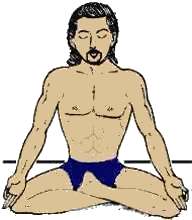| |
 |
apid |
Just what you need to know! |
| eview |
|

Basic Facts about the Yoga Posture (Asana)
The Perfect Posture (whose original Indian name is Siddhasana) in Yoga is suitable for improving a person's concentration. It is a posture, next in importance to the Lotus Posture (Padmasana or Kamalasana), recommended for meditation (Dhyana) and for chanting mantras (Japa).
Note that Siddha means a Semi-divine Being with great sanctity. This posture gets its name because the person performing this pose attempts to emulate a sage who is perfect, a prophet who is accomplished, or a seer who is adept.
Stepwise Technique 
- Sit on the ground with your head and spine erect without drooping your shoulders. Extend your legs forward such that your knees and heels are placed together. With the help of your hands, place your right foot against your left thigh. Next, place your left foot over your right ankle. The soles of the feet must touch the thighs, and the heels must be close to the pubic bone.
- Touch the thumb of each hand to the index finger at the tips to form a circle. Ensure that the other three fingers are straight. Rest your left hand on your left knee and your right hand on your right knee with the palms facing upwards. Keep your arms straight at the elbows. This hand position is called Jnana Mudra (Knowledge Hand Gesture) because it signifies the knowledge of connecting the Individual Soul (Atma) with the Supreme Soul (Paramatma).
- Remain in this final posture with your eyes closed for about 1-2 minutes (in the early stages) or your breakpoint*. Increase this time gradually to several minutes.
- Repeat the above steps with your left foot placed first against your right thigh and your right foot then placed over your left ankle. This will ensure that both legs are built uniformly.
Tips and Comments
- In Step 2, the hands were positioned in Jnana Mudra (Knowledge Hand Gesture). They may be alternatively positioned in Dhyana / Padma Mudra (Meditation / Lotus Hand Gesture) or Drona Mudra (Bowl Hand Gesture) as described below.
- Bend your arms at the elbows and place your hands below your navel on your lap. Keep the palms (a little cupped and with extended fingers) one on top of the other (usually, right palm on the left palm). The thumbs may either be straight or touch at the tips to form a triangle. This hand position is called Dhyana Mudra (Meditation Hand Gesture) because it is the hand posture recommended for meditation, or Padma Mudra (Lotus Hand Gesture) because it looks like the lotus petals.
- Rest your left palm on your left knee and your right palm on your right knee with the cupped palms facing downwards. Keep your arms straight at the elbows. This hand position is called Drona Mudra (Bowl Hand Gesture) because the palm is shaped like a bowl (Drona) covering your knees.
- Instead of keeping the eyes closed, you may focus on the nose tip (Nasagra Drishti) or between the eyebrows (Bhrumadhya Drishti).
- It is possible to remain in the Perfect Posture (Siddhasana) for even a few hours. However, care must be exercised to check for discomfort during as well as after the asana.
- Rather than keep the neck erect and look straight ahead, a minor variation of this yoga posture is to keep the neck bent and look downwards with the chin touching the chest.
- *Breakpoint is the time upto which you can comfortably remain in a yoga posture. It varies from individual to individual depending on one's fitness, age and will power.
Potential Benefits of the Yoga Posture (Asana)
- The Perfect Posture (Siddhasana) is believed to help in arousing the divine cosmic power (Kundalini Shakti) dormant in the lowest nerve center at the spinal column base by purification of the nadis (ducts for passage of nervous energy). Further, it is believed that the yoga posture helps in attaining supernatural powers (siddhis).
- The yoga posture helps reduce excess fat in the body especially in the abdominal region. It aids in better functioning of the digestive and excretory systems.
- The yoga posture assists in the cure of pain in the knees, ankles, and back. Its practice helps those suffering from insomnia and asthma.
- The yoga posture keeps the mind focused because it requires one to sit upright. It is a posture often suggested for practicing Breath Control (Pranayama), Concentration (Dharana), Meditation (Dhyana) and Self-realization (Samadhi).
Disclaimer : Syvum makes no representations or warranties of any kind, express or implied, as to the correctness of the content as well as the accuracy and use of the information regarding the practice of Yoga. It is strongly advised that you consult your physician before engaging in any physical activities. The information herein is not intended to substitute professional medical opinion or qualified Yoga instructors' opinion. To the full extent permissible by applicable law, Syvum disclaims all warranties, express or implied, including but not limited to, implied warranties and fitness for a particular purpose. Syvum will not be liable for any damages of any kind arising from the use of the information regarding the practice of Yoga, including but not limited to direct, indirect, incidental, punitive and consequential damages.
|
|

